The best AI tools for converting a book into an audiobook include ElevenLabs, Play.ht, and Murf AI.
The way people consume content is changing fast. Readers are becoming listeners choosing podcasts and audiobooks over long-form text. For authors, marketers, and growth-stage SaaS teams, that shift isn’t a threat, it’s a massive opportunity.
This comprehensive blog post will guide you through the process of turning your book into an audiobook using the best AI tools available.
▶️ Traditionally, producing an audiobook required expensive studios, professional narrators, and weeks of editing. But today, AI-powered narration tools make it possible to turn any book, guide, or long-form asset into a high-quality audiobook in just hours — at a fraction of the cost (and often after an initial AI content audit software passes to spot issues that will surface in audio).
The audiobook market is booming, and AI tools are making it easier than ever for authors to convert their written works into audiobooks. This surge in demand means there’s never been a better time to leverage AI for audiobook production.
Whether you’re an author looking to bring your story to life or a content-led B2B brand aiming to repurpose ebooks and reports into engaging audio, AI tools are rewriting the rules of production and accessibility.
If you’re thinking about the foundation first, here’s a how to do a content audit guide that ensures your text is structurally sound before narration.
👉 In this 2025 guide, we’ll explore the best AI tools to turn your book into an audiobook comparing their voice quality, ease of use, pricing, and platform compatibility. You’ll also learn how these tools work, what to look for, and how to create a professional audiobook that sounds every bit as natural as a human narrator.
If you’d rather have a partner build the content engine around your audio strategy, our SaaS content marketing services can help align topics, formats, and distribution.
By the end, you’ll know exactly which tool fits your goals, and how to use AI narration to scale your content, extend your brand voice, and connect with audiences who prefer to listen, not read.
▶️ Ready to deploy an AI-first content strategy? Book your consultation with The Rank Masters
Hiring a professional narrator can be expensive, typically costing between $50 to $400 per finished hour of audio.
Table of Contents
Best AI Tools to Turn Your Book Into an Audiobook (2025 Edition)
In 2025, AI audiobook creation has matured from robotic voiceovers into expressive, high-fidelity storytelling. The right platform can save 80-90% of production time compared to hiring a human narrator, while still delivering studio-level quality.
Below are the top AI tools worth your time (and budget). Each has been evaluated for realism, usability, pricing flexibility, and commercial scalability, critical for content-led SaaS teams repurposing long-form assets into voice formats.
| Tool | Best For | Voice Quality |
|---|---|---|
| ElevenLabs | Authors, founders, and storytellers who want lifelike, emotional narration | (Exceptional realism and emotion) |
| Play.ht | Fast production and global reach for teams repurposing long-form content | (Natural and expressive) |
| Murf AI | Beginners or small SaaS teams wanting simple, drag-and-drop audio creation | (Balanced and clear) |
| WellSaid Labs | Professional studios or brands needing premium, consistent narration | (Studio-grade human realism) |
| Speechify | Casual creators or educators creating short-form audiobooks | (Good for simple use cases) |
| Google Play Books (AI Narration) | Self-publishing authors testing AI audio formats | (Basic but improving) |
1. ElevenLabs — Best Overall for Realistic, Emotional Narration
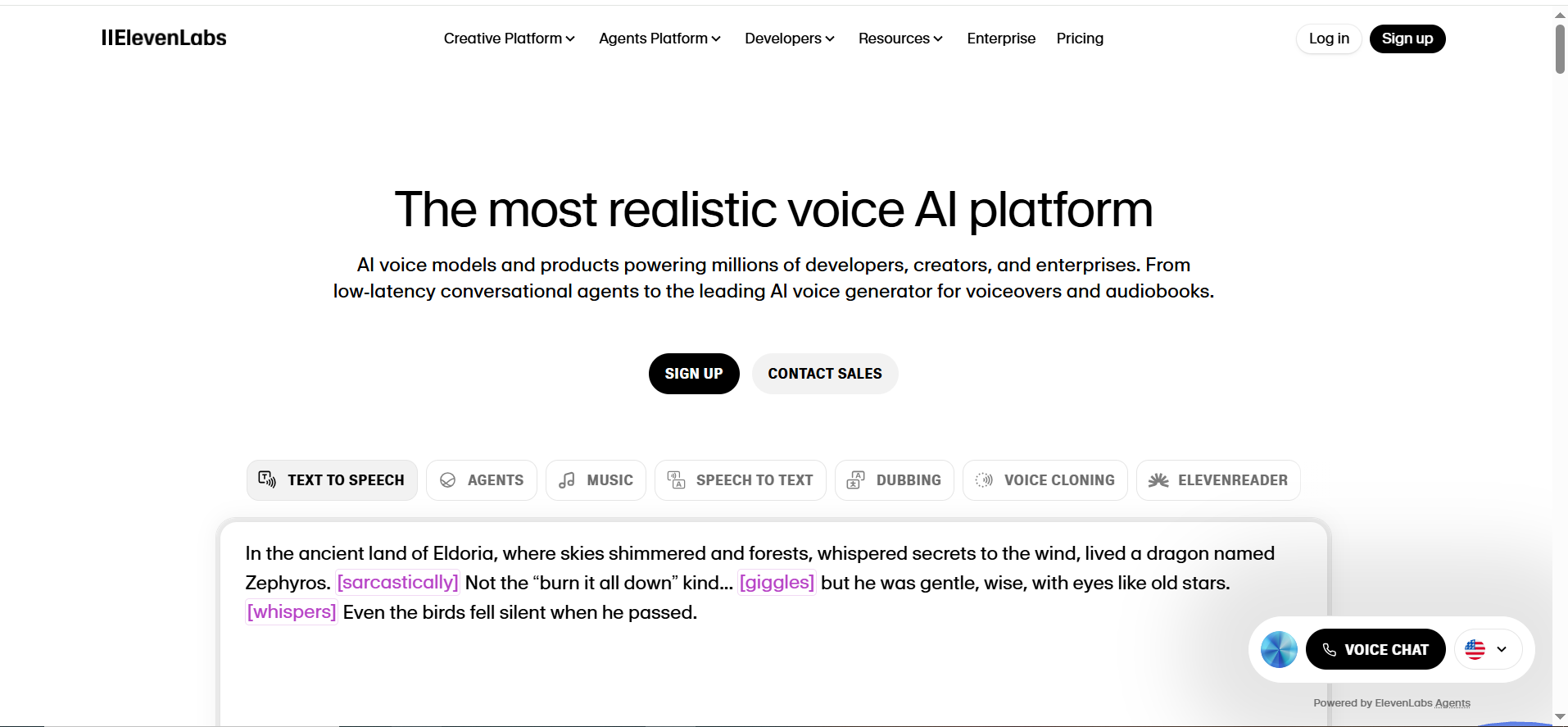
Why it stands out: ElevenLabs is the current industry leader in lifelike voice generation. Its proprietary Voice AI 2.0 engine captures emotion, tone, and pacing far beyond traditional text-to-speech systems, allowing even subtle character differentiation or conversational nuance.
What makes it special:
- Natural, expressive narration — voices pause, breathe, and emphasize like humans.
- Generate an entire audiobook with one click — easily produce a complete audiobook in diverse voices and styles, streamlining the traditional process.
- Handles long manuscripts easily — supports chapters, scene continuity, and consistent tone across an entire book.
- Advanced editor — tweak pronunciations, adjust emphasis, or re-render small sections without reprocessing the whole file.
- Flexible pricing — traditional audiobook production is often priced per finished hour, but ElevenLabs offers pay-as-you-go or subscription models, making it more accessible for various project sizes.
- Commercial-use license — paid plans include full commercial rights, allowing distribution on platforms like Spotify and Apple Books, as well as Audible or your brand’s own channels.
Best for: Authors, founders, and marketers who want professional-grade narration without hiring a studio team.
Pro Tip: Many SaaS founders use ElevenLabs to convert long-form essays, webinars, or case studies into brand podcasts, perfect for awareness and retention in content-led growth motions.
ElevenLabs supports over 30 languages, enabling authors to reach a global audience with localized narration.
2. Play.ht — Best for Fast, Scalable Audiobook Creation
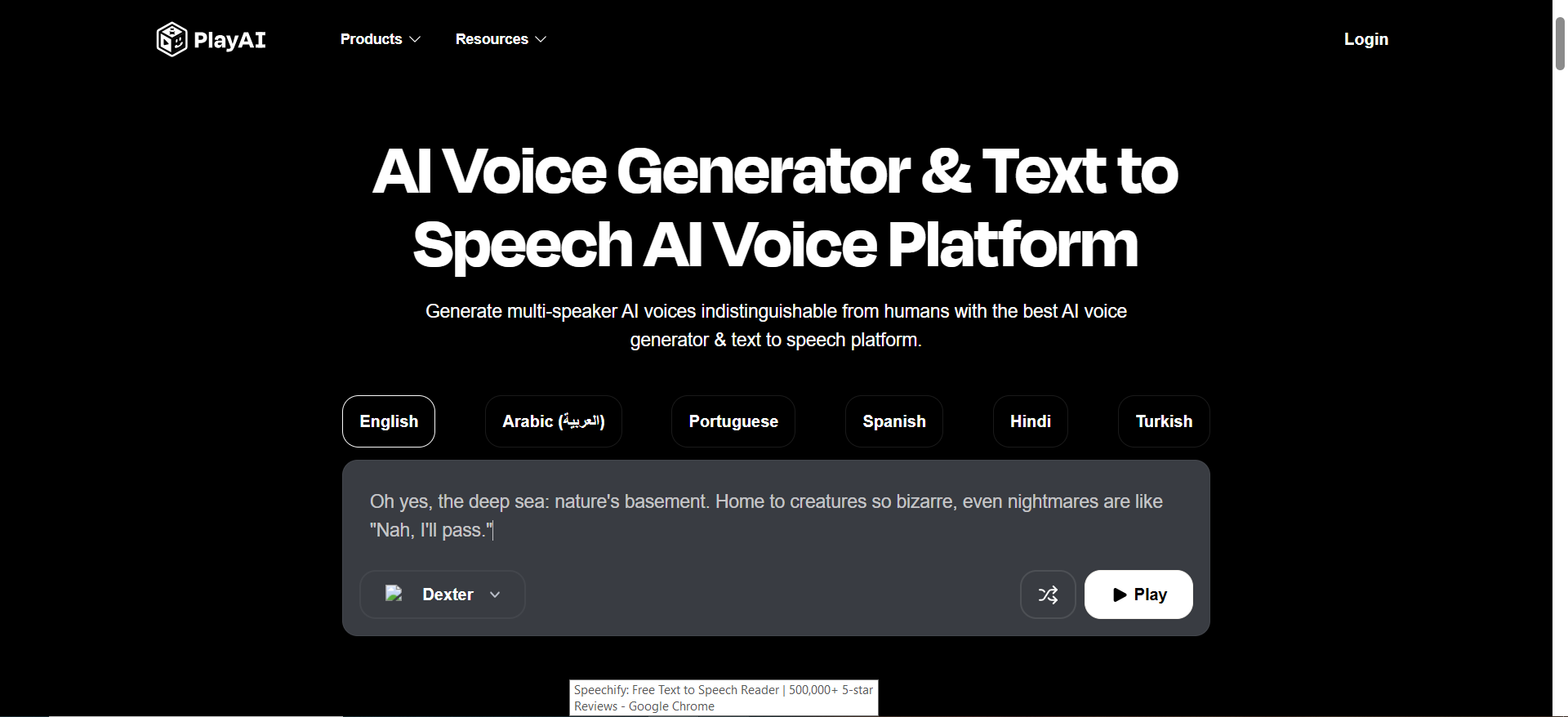
Why it stands out: Play.ht focuses on speed, volume, and simplicity. It’s a favorite among indie authors and marketing teams producing high volumes of content. Upload your manuscript, pick a voice, and export an audiobook-ready file in minutes. Play.ht uses AI generated voices that sound natural and offer a wide variety of narration styles, making your audiobook engaging and customizable while reducing production time and costs.
What makes it special:
- High-speed processing — create hours of narration within minutes.
- Long-form text support — uploads entire manuscripts or bulk content (perfect for multi-chapter books).
- 400+ voices in 60+ languages — AI voice generators support multiple languages, enabling authors to reach a wider audience.
- One-click export — compatible with Audible, Google Play Books, Spotify, and more.
- Transparent pricing — simple monthly plans and a free tier for testing.
Best for: Growth-stage brands repurposing ebooks, whitepapers, or thought-leadership guides into listenable assets for demand generation.
Use Case: A B2B SaaS team turns its quarterly report into a narrated “audio digest” for leads who prefer to listen during commutes or workouts — boosting touchpoints and dwell time.
3. Murf AI — Best for Beginners and Non-Technical Teams
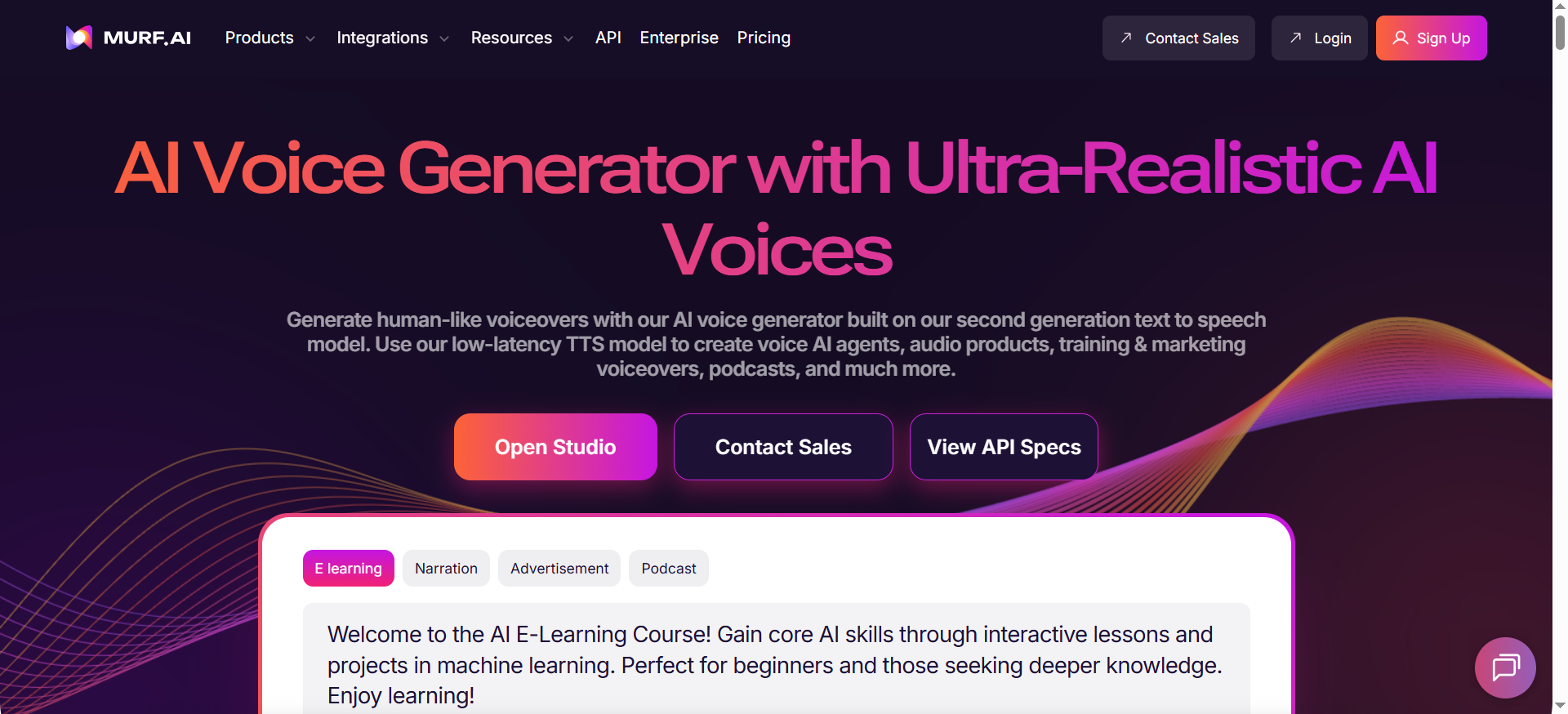
Why it stands out: Murf AI brings pro-level audio creation to non-technical users. Its drag-and-drop studio functions as an audio editor, allowing users to fine-tune narration and add effects. The interface is beginner-friendly, requiring zero editing skills, making it perfect for content or growth teams without in-house audio talent.
What makes it special:
- Studio-like audio editor interface — beginner-friendly, lets you add text, select tone, and integrate background music or sound effects directly on a timeline.
- 120+ realistic voices across genders, tones, and languages.
- Built-in background tracks — create ambient or branded audiobook experiences.
- Commercial rights included — no hidden fees for monetizing or publishing your audiobook.
- Integrations — export directly into video explainers or podcast snippets for multichannel reuse.
Best for: Marketers, content managers, or SaaS teams creating voice-over versions of blogs, webinars, or onboarding guides.
Micro-Checklist:
✅ Upload your manuscript
✅ Choose the tone (informative, storytelling, friendly)
✅ Add optional background audio
✅ Export your ready-to-publish audiobook.
4. Speechify — Best for Short-Form or Lightweight Projects
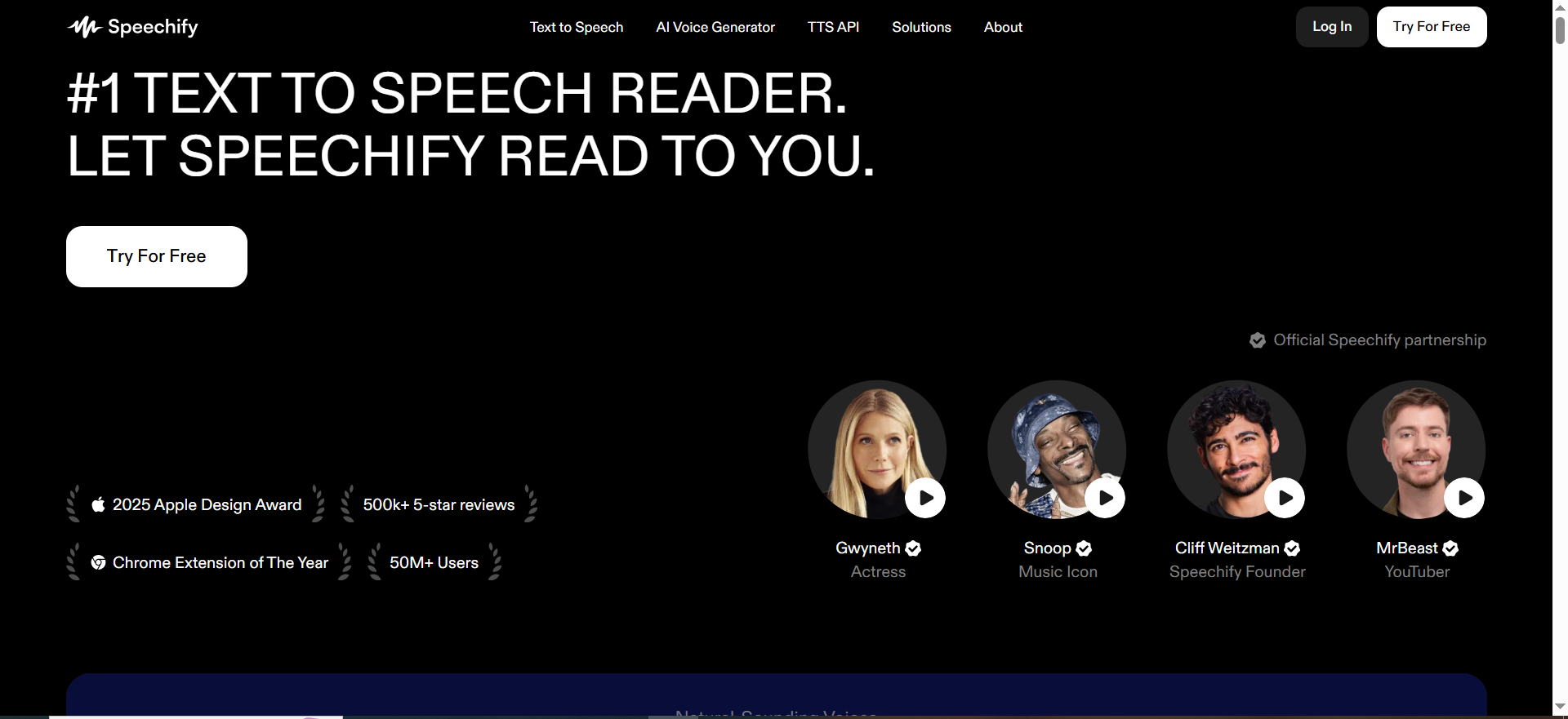
Why it stands out: Speechify offers a quick, browser-based experience that converts text into natural audio with minimal setup. It's designed for creators who want to test the audiobook format before committing to large-scale projects.
What makes it special:
- 100% web-based — no software downloads.
- Multiple realistic voices (including celebrity clones in beta).
- Great for short-form — blog posts, guides, or email content.
- Affordable and flexible — free trial with low-cost premium plans.
Best for:Freelancers, indie authors, or SaaS content teams experimenting with micro-audio formats like narrated blogs or “audio newsletters.”
Heads-up: Voice quality is improving rapidly but may still sound slightly synthetic for multi-hour narrations or fiction works.
5. WellSaid Labs — Best for Studio-Quality, Professional Narration
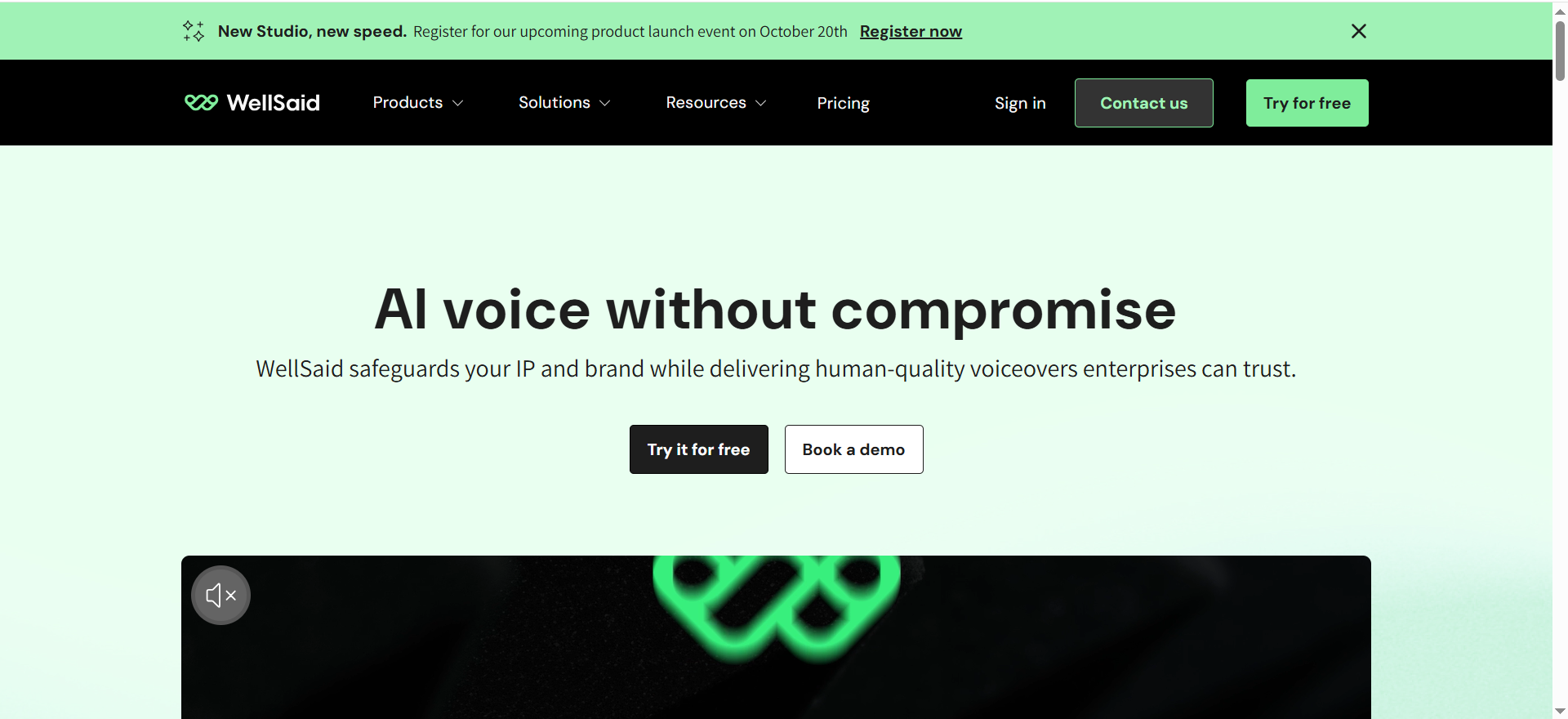
Why it stands out: WellSaid Labs is the enterprise-grade platform trusted by major publishers and production studios. It prioritizes depth, tone control, and studio realism, producing narration nearly indistinguishable from human professionals.
What makes it special:
- Top-tier realism — emotional inflection, natural phrasing, and lifelike tone shifts.
- Best voice selection — choose the best voice for your project, ensuring maximum quality and realism.
- Voice-clone options — create custom AI voices matching your brand’s persona.
- Developer API — automate audiobook production or integrate with your CMS.
- Enterprise-level support — perfect for scaling content operations or brand-specific voice systems.
- Premium pricing — higher cost, but unmatched polish and licensing clarity.
Best for: SaaS companies or agencies producing branded, high-production-value audio experiences — such as narrated product stories, leadership books, or thought-leadership series, and those who need to select the best voice for each project.
Pro Insight: WellSaid Labs is ideal for companies seeking brand consistency across all spoken assets — from podcasts to training modules. While WellSaid Labs is unmatched in studio realism, ElevenLabs is widely regarded as an industry leader for high-quality, professional-grade AI audiobooks due to its advanced voice synthesis technology.
Bonus: Apple Books & Google Play AI Narration
Major distribution platforms like Apple Books and Google Play now include native AI narration options for authors publishing directly, allowing you to easily create an audiobook version of your book using AI narration.
- Great for self-publishers looking for simple, free narration tools.
- Limited voice variety and customization.
- Excellent for frictionless distribution — no external uploads or file conversions required.
- Authors can distribute their audiobooks through platforms like Google Play Books and Kobo, which accept AI narration.
💡 Quick Take: Ideal for testing audiobook formats on small titles or using as a secondary channel for exposure.
What Readers Are Really Searching For
When someone types “best AI tool to turn your book into an audiobook” into Google or an AI search engine, they’re not just looking for another list of software tools.
They’re looking for clarity, confidence, and proof that these tools actually work without the tech jargon or marketing fluff. For teams prepping manuscripts before narration, a ensures structure, headings, and accessibility won’t trip up your audio later.
Here’s what they really want to know:
- Human-sounding voices: Natural, expressive narration that doesn’t sound robotic.
- Affordable pricing: Plans that scale with project size and budget.
- Full-book support: Ability to handle long manuscripts, not just short scripts.
- Simple workflow: Easy upload → generate → export process.
- Legal clarity: Confidence that AI-narrated books are accepted on platforms like Audible, Spotify, or Google Play. When it comes to distribution, it makes sense to choose a strategy—exclusive or non-exclusive—based on your goals and where your audiobook performs best.
Once the audiobook is created, authors need to choose a distribution strategy to reach their audience.
How AI Audiobook Tools Work
AI audiobook tools use next-generation text-to-speech (TTS) and neural voice synthesis technologies to transform written words into lifelike narration. Modern AI audiobook tools produce human like voices by replicating human speech patterns, resulting in natural sounding audiobooks that closely mimic real human narration. AI voice generators employ deep learning models to convert written text into spoken words with uncanny realism.
AI audiobook conversion relies on sophisticated Text-to-Speech (TTS) technology powered by deep learning and neural networks. If you want to automate pre-flight checks for readability and tone consistency, explore AI content audit software to catch issues before you hit “generate.”
You simply upload your manuscript — typically as a PDF, DOCX, or EPUB — choose a voice, and the AI automatically converts the text into audio that sounds smooth, natural, and expressive. What sets modern tools apart is their ability to capture emotion, pacing, and tone variation. Instead of flat robotic voices, these systems can express curiosity, excitement, or calm depending on the context of your writing.
Teams that want a fast, guided path from “rough draft” to “ready for narration” can leverage our SaaS content audit & fix sprint to tighten copy and reduce post-production edits.
And the best part?
You don’t need to be a sound engineer or have studio experience. Platforms like ElevenLabs and Play.ht make it possible for anyone “authors, marketers, or SaaS teams” to generate professional-quality narration in minutes.
Advanced AI tools can even:
- Differentiate characters in dialogue-heavy text
- Pronounce brand names or technical terms correctly
- Match emotion and rhythm to the mood of your story
In short, AI audiobook creation has become as simple as exporting a PDF — but with the storytelling power of a studio-quality voice actor.
AI Narration vs Human Narration
When it comes to creating audiobooks, the choice between AI narration and human narration is more relevant than ever. Thanks to advances in text to speech technology, AI voices can now produce natural sounding ai voices that rival traditional voice actors in clarity and consistency. AI narration uses sophisticated algorithms to transform your manuscript into high quality audio files, making it possible to create audiobooks quickly and affordably.
AI narrated audiobooks are ideal for authors and publishers who want to produce audio content at scale, meet tight deadlines, or experiment with different narration styles. With AI, you can select from a range of voices, adjust pacing, and even generate audio in multiple languages—all without the need for a recording studio or professional narrator. This approach is especially effective for non-fiction, business guides, or educational content where a clear, consistent delivery is key.
On the other hand, human narration brings a unique emotional depth and personal touch to the audiobook experience. A skilled voice actor can interpret subtle cues in the text, deliver nuanced performances, and connect with listeners on a deeper level. This makes human narration a strong choice for fiction, memoirs, or any project where character and emotion are central to the story.
Ultimately, the decision between AI narration and human narration depends on your goals, budget, and the type of content you’re producing. If you need to create audiobooks efficiently and cost-effectively, AI narrated solutions offer a compelling path with natural sounding ai voices and fast turnaround.
For projects that demand a more intimate or dramatic performance, human narration remains the gold standard. Either way, today’s technology ensures you can deliver a professional, engaging audiobook to your audience.
AI-generated audiobooks can lack emotional nuance or character voice depth compared to human narration.
Step-by-Step: How to Turn Your Book Into an Audiobook with AI
Converting your manuscript into an audiobook isn’t just about hitting “generate.” This is where the audiobook creation process comes in—a streamlined, technology-assisted workflow that makes production easy and ensures high-quality audio output.
Creating an audiobook involves several steps, including preparing the text, selecting a narration style, and recording the audio. It’s about preparing content that sounds natural, flows smoothly, and aligns with your brand or author voice.
Here’s a simple 5-step playbook to help you produce a professional AI-narrated audiobook — from draft to distribution.
Step 1: Prepare Your Manuscript (Set the Foundation)
Before you upload anything, spend a few minutes cleaning your text. For a structured pre-flight, this helps you standardize headings, spacing, and readability so narration sounds clean.
AI tools read exactly what's on the page, every typo, punctuation mark, and stray hyperlink can disrupt the flow.
Think of this step as “soundproofing” your manuscript before the AI voice starts recording.
How to do it:
- Break your book into logical chapters or sections (helps pacing and file management).
- Remove all images, hyperlinks, and footnotes — they don't translate well into audio.
- Standardize punctuation, paragraph breaks, and headings for clear pauses and tone shifts.
✅ Checklist:
- Clean formatting (no HTML clutter)
- Consistent punctuation and spacing
- Separate chapters into individual files or headings
Pro Tip: Tools like Grammarly or Hemingway help polish your text before upload — smoother text equals smoother narration.
Step 2: Choose the Right AI Tool (Your Production Engine)
Not all AI narration tools are built the same. Some focus on speed and affordability (like Play.ht), while others deliver emotional storytelling (like ElevenLabs). The right tool depends on your goal: is it to publish on Audible, create branded voice assets, or test audiobook demand?
If you prefer a process-first approach, this AI SEO tools agile workflow shows how to evaluate tools within a repeatable production loop.
How to do it:
- Compare voice demos — pay attention to tone, warmth, and clarity.
- Check each platform's licensing terms if you plan to sell the audiobook commercially.
- Factor in budget, export options, and text length limits.
✅ Checklist:
- Tool supports long-form content
- Voice tone matches brand personality (friendly, serious, inspiring)
- Commercial rights are included
Pro Tip: Run a short 1-page test with 2–3 voices before committing — what sounds “real” in a 10-second demo can differ over 6 hours of narration.
Step 3: Upload and Generate (The Fun Part)
Now it's time to bring your manuscript to life.
Upload your text or import your document (DOCX, EPUB, or plain text). Choose a narrator voice that fits your genre — calm and educational for non-fiction, expressive and dynamic for fiction.
How to do it:
- Paste or upload your text into the editor.
- Select a voice and adjust speed, tone, and pacing.
- Many tools allow pauses, emphasis, and pronunciation tweaks — use these to mimic human rhythm.
- Generate a short sample first to test the flow before rendering the full audiobook.
✅ Checklist:
- Correct voice and pacing chosen
- Custom pauses or emphasis applied where needed
- Sample test sounds smooth and natural
Pro Tip: Label each section (e.g., “Chapter 1 – Introduction”) in the editor so the AI automatically adds pauses between sections.
Step 4: Review & Edit (Quality Check Pass)
Don't skip this step — it's the difference between an average AI audiobook and a professional one.
Even advanced AI narrators sometimes mispronounce names, emphasize the wrong words, or sound rushed in transitions.
How to do it:
- Listen to every chapter and note inconsistencies.
- Fix mispronunciations using phonetic spelling or pronunciation editors.
- Adjust emphasis for key sentences — emotion matters as much as accuracy.
- Ensure smooth transitions between chapters (avoid abrupt starts or silence gaps).
✅ Checklist:
- Mispronunciations corrected
- Chapter openings and endings sound seamless
- Background noise or clipping removed
Pro Tip: Have a friend or team member listen to one chapter fresh — they'll catch tone or pacing issues your brain has tuned out.
Step 5: Export and Distribute (Go Live)
Once you’re happy with the final version, it’s time to share your creation with the world — or your target audience. Each platform (Audible, Spotify, Google Play Books, etc.) has specific technical requirements, but most accept standard MP3 or WAV files.
If you are using AI narration, it’s important to note that many audiobook platforms do not allow the publication of audiobooks generated using AI. For example, ACX does not accept AI-narrated audiobooks, which limits distribution options for AI-generated content. However, you can distribute AI-narrated audiobooks on platforms like Findaway Voices and Authors Republic. These services act as non-exclusive distributors, allowing you to distribute your own audiobook widely across multiple retailers such as Spotify, Apple Books, and Kobo. F
Findaway Voices is a popular choice for authors who want broad exposure and it accepts AI narration. Always check each platform’s policy to ensure they accept AI-narrated audiobooks before distributing.
If part of your strategy includes discoverability through assistants and voice experiences, skim voice search SEO for SaaS to align titles, descriptions, and script snippets with conversational search.
How to do it:
- Export your audiobook in 44.1kHz MP3 or WAV format.
- Add proper metadata: author name, book title, short description, and cover art.
- Upload to your chosen platform(s) or host on your website for gated access.
- Promote it through your SaaS content channels, newsletters, blogs, or podcast feeds.
✅ Checklist:
- Audio files exported in correct format and quality
- Metadata and cover art added
- Uploaded to desired platforms
- Distribution links added to marketing campaigns
Pro Tip: Repurpose your audiobook, share snippets on social media, use clips in paid ads, or gate the full version as a lead magnet for demo signups.
Tips to Make Your Audiobook Sound Human
AI voices have come a long way, but the difference between “good” and “great” comes down to small, intentional details.
Here’s how to make your audiobook sound natural and emotionally engaging.
👉 Start by adding natural pauses between sections or chapters. This creates rhythm, makes transitions smoother, and gives listeners time to absorb information. It’s especially useful in non-fiction and instructional content. For a collaborative pre-flight checklist you can use with editors, try the Google Docs SEO workflow to standardize headings, pacing cues, and stage-gate reviews.
👉 Next, adjust the emphasis and pacing. Flat, robotic narration often happens when every word is treated equally. Most AI tools let you tweak pacing and stress on key words — use that to your advantage to create natural flow and tone. When polishing before render, a quick pass with best AI proofreading tools helps catch rhythm-breaking grammar and punctuation that TTS will read literally.
👉 Choose a voice and style that fit your story or brand personality. A calm, confident voice works best for business guides or SaaS explainers, while an expressive tone fits better for storytelling or founder-led content. To keep language human-safe and non-robotic across chapters, follow safe AI writing for SEO so your script stays natural while remaining platform-friendly.
👉 Consider diy narration as an alternative to AI. DIY narration gives you full creative control and a truly human touch, but it does require a quiet recording space, a quality microphone, and recording software like Audacity. This approach can be more budget-friendly if you already have the equipment and are willing to invest the time.
👉 Finally, always preview your audiobook before publishing. Listen from start to finish, not just for technical errors but also for emotional consistency. Play it on different devices (headphones, car speakers, phones) to ensure it sounds professional everywhere. To strengthen trust in narrator selection, add bylines or context that establish author credibility for SaaS content (useful for business titles and founder-led narratives).
Common Mistakes to Avoid
| Mistake | Why It’s a Problem | How to Avoid It |
|---|---|---|
| Choosing robotic or monotone voices without testing samples | Flat or mechanical narration reduces listener engagement and credibility, especially for long-form books. | Always preview multiple AI voices before generating the full audiobook. Choose expressive or natural tones that match your content style. |
| Ignoring pronunciation issues (especially for names or brands) | Mispronounced company names or jargon break immersion and hurt brand perception. | Use your AI tool’s pronunciation editor or phonetic spelling options to fix problem words before final export. |
| Not checking file quality before distribution | Poor audio quality (pops, inconsistent volume, or clipping) can cause listener drop-off and rejections from platforms like Audible. | Always listen to the full export and check bitrate (44.1kHz MP3/WAV). Test playback on multiple devices. |
| Violating usage rights of the AI tool | Some AI tools restrict commercial or resale use of generated voices. Ignoring this can lead to legal issues or takedowns. | Review each platform’s license terms. Choose tools that grant full commercial rights for audiobook distribution. |
Distribution Models: Exclusive vs Non-Exclusive
Choosing the right distribution model is a crucial step in bringing your ai audiobook to market. Authors and publishers can opt for exclusive distribution, where the audiobook is available only on a single platform—such as Audible or ACX. This approach often comes with higher royalty rates and prominent placement within that platform’s ecosystem, making it attractive for those seeking maximum earnings per sale. However, exclusive distribution limits your audiobook’s reach, as listeners can only access it through that specific service.
Non-exclusive distribution, by contrast, allows you to publish your audiobook across multiple audiobook platforms, including Google Play Books, Apple Books, and more. This model gives you the flexibility to reach global audiences and tap into different markets, increasing your audiobook’s visibility and potential sales. While royalty rates may be slightly lower, the broader reach can often compensate for this difference.
With the rise of ai audiobook generators and customizable voices, non-exclusive distribution is becoming increasingly popular among indie authors and publishers who want full control over their content and marketing. Platforms like Google Play and Apple Books make it easy to upload ai generated audiobooks, ensuring your work is accessible to listeners wherever they prefer to buy or listen.
When deciding between exclusive and non-exclusive distribution, consider your target audience, marketing strategy, and long-term goals. If you value higher royalties and a streamlined approach, exclusive distribution may make sense. If you want to maximize reach and retain flexibility, non-exclusive distribution is the way to go. Either model can work well with today’s ai audiobook tools, so choose the path that aligns best with your vision for your audiobook.
Monetization and Marketing for Your AI Audiobook
Successfully monetizing and marketing your ai audiobook requires a blend of smart platform choices, creative promotion, and leveraging the latest ai voice technology. Start by selecting audiobook platforms that align with your goals—whether it’s ACX, Google Play Books, Apple Books, or emerging ai platforms. Each offers different pricing models, royalty structures, and opportunities for exclusive or non-exclusive distribution.
To maximize your audiobook market potential, consider offering your ai generated audiobooks in multiple formats and languages. Voice cloning and voice customization features let you tailor the narration style, add background music, or even use your own voice for a unique listening experience. High quality audio and natural sounding narration are key to standing out in a crowded audiobook industry.
Marketing your ai audiobook goes beyond simply uploading it to a platform. Use social media, email newsletters, and audiobook blogs to build buzz and connect with audiobook enthusiasts. Create engaging audio content—like YouTube videos, podcast interviews, or behind-the-scenes clips—to showcase your narration style and reach new listeners. Offering limited-time discounts, free trials, or bonus content can encourage reviews and word-of-mouth promotion.
Don’t forget to optimize your audiobook file with proper metadata, cover art, and compelling descriptions. Tools like audio editors and editing software can help you polish the final product, ensuring a professional listening experience. By combining effective monetization strategies with creative marketing, you can turn your ai narrated audiobook into a true game changer—reaching global audiences, building your brand, and generating ongoing revenue in the evolving audiobook market.
The Future of AI Audiobooks
The world of AI audiobooks is evolving fast. What started as basic text-to-speech has now turned into multi-voice, emotionally aware storytelling
Modern tools like ElevenLabs and WellSaid Labs are introducing multi-character narration, allowing you to create full-cast audiobook experiences where each character has a unique, expressive voice. Some platforms even detect emotional tone automatically — shifting from calm to excited or serious depending on the text. Forward-looking teams also think about how these audio assets surface in AI results; investing in answer engine optimization services ensures your audio pages are structured for AI overviews and assistants.
Voice cloning is another major leap forward. Authors and brands can now use their own voices to narrate their books, maintaining authenticity while scaling production. This opens doors for founder-led storytelling, product explainers, or even audio-based customer education programs. If you're planning large-scale rollouts (multiple playbooks, product lines, or locales), programmatic SEO services can help you build the landing and support pages that connect listeners to next steps.
Even major platforms like Audible and Apple Books are exploring AI narration, signaling that synthetic voices are becoming mainstream. This shift will redefine how content is produced and consumed. For growth-stage teams, pairing audio with a strong SaaS SEO agency strategy turns passive listening into qualified traffic across docs, changelogs, and help hubs.
Turning existing content “like product guides, case studies, or whitepapers” into narrated audio versions allows you to reach audiences who prefer to listen, not read. It's a new layer of content repurposing that extends reach, boosts engagement, and compounds ROI across channels. To capture that interest inside your product and docs, consider CRO for product-led content to guide listeners toward trials, demos, or feature adoption.
💡 Example:A B2B SaaS company turns its 40-page onboarding guide into a 25-minute “Welcome Audio Walkthrough.” It becomes part of their onboarding emails, YouTube playlist, and Spotify feed — instantly multiplying the content's lifespan and impact.
Frequently Asked Questions
Audible is gradually testing AI narration in selected genres and markets. Check the latest ACX policies to confirm eligibility before submitting your AI-generated audiobook.
Yes, as long as the AI platform grants commercial usage rights. Always verify the tool’s licensing terms to avoid restrictions or takedowns.
Currently, ElevenLabs and WellSaid Labs lead in realism, emotion, and expressive tone, producing results that are nearly indistinguishable from human narrators.
Yes. Many premium tools now support voice cloning, allowing authors, founders, or brands to replicate their voice for consistent storytelling and personal branding.
Conclusion: Choosing the Right Tool for You
There’s no one-size-fits-all when it comes to AI audiobook tools — the right choice depends on what you value most.
▶️ If you want the most human, emotional narration, go with ElevenLabs.
▶️ If your focus is speed, scale, and ease, Play.ht is your best bet.
▶️ If you want something simple and beginner-friendly, Murf AI offers a great balance.
And if you’re building studio-quality brand assets, WellSaid Labs is unmatched in realism.
For testing ideas or creating shorter audio snippets, Speechify or Google Play’s built-in AI narrator are great entry points.
One of the biggest benefits of using AI tools is the reduced upfront cost of audiobook production compared to traditional methods, making it more accessible for authors and brands. At the end of the day, AI narration isn’t just a convenience “it’s a new growth channel‘. It helps SaaS and B2B brands reach audiences where they already are: in their earbuds, during their commute, and in their daily workflows. If you want a second set of eyes on the plan before you commit, this content audit consultant guide shows how to validate your script quality and distribution paths.
So, whether you’re a founder-author or a content marketer, this is your chance to take your book or your brand from text to sound. AI voice technology enables authors to create audiobooks quickly and efficiently, expanding their reach to global audiences.




